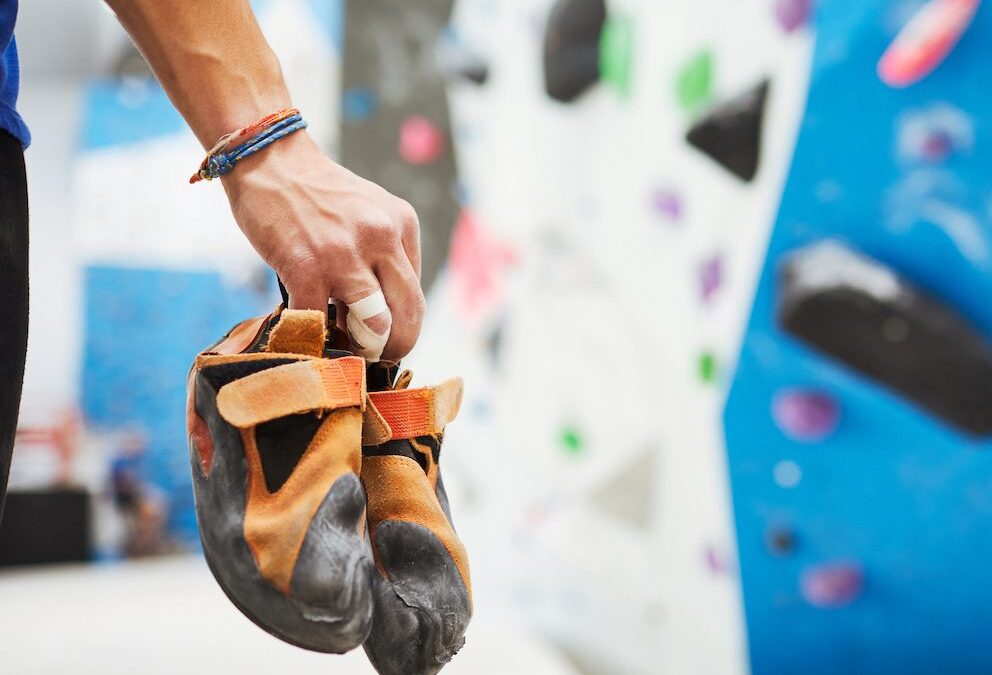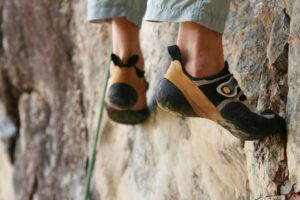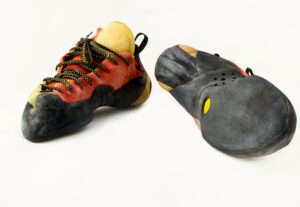Are Old Climbing Shoes Better for Training?
Is it better to train for climbing in new shoes or old? What are the advantages of each, and when does a shoe become old?

For boulderers living in North America’s warmest crags, the summer is for training. Even many rope crags become nasty in July, leading sport climbers back indoors and into their favorite training shoes. But what do those shoes look like? Is there an advantage to having better or worse shoes when you’re climbing at the gym?
The Cycle
Climbers buy rock climbing equipment. As such, many climbers’ newest shoes go toward their outdoor projects in order to optimise the footholds they encounter. After they receive some wear, or a lot of wear, they are cycled back into the climber’s bag as a gym shoe. The fresh weapons replace their older counterparts.
This method makes logical sense to any climber on a budget, but at what point do those indoor shoes become too damaged to continue? Does such a point exist?
Why train in bad shoes?
Given the option, why train in bad shoe?. Perhaps the first answer comes from the fact that many don’t have an option. Climbers will use what they have access to. Sometimes worn out climbing shoes are the best option because they are the only option.
With that said, there are numerous climbers who purposefully train in bad shoes, or purposely purchase less aggressive, less ideal climbing shoes for indoor training as a supplemental training tool. The logic appears sound. If the shoes are bad, then the climber will have to rely more on their own strength than the quality of their shoes to make it to the top.
Flat shoes require the climber to push much harder with their toes in an overhang. Similarly, shoes with broken straps force the climber to heel hook, toe hook, or twist with control. Otherwise, the shoe slides off.
In terms of precision and strength, it seems that bad shoes are better teachers than good ones.
Why train in good shoes?
The problem with this concept, however, is that climbers will train as though their feet will not stay on. On big power moves, it probably matters less than on stretched tenuous movements, but the concept remains. More tenuous moves will begin to look like power moves if you cannot keep your foot on.
When you begin climbing, people tell you to use your feet because it makes the climbing easier when something is at your technical limit. On a board or on a gym boulder, cutting feet is often the easiest way to get up the wall, but outdoors, the climb is often impossible for your strength level if you lose the foot. As such, training how to keep your feet on is important.
While bad shoes mean that your core will strengthen if use them and keep your foot on, technical progress is perched upon that prerequisite. Conversely, good shoes are so much better than old beaters that climbers are almost asked to use their feet with a greater propensity. When you wear good shoes, your body moves under the presumption that your foot will and can stay on.
A good shoe will be able to hold on to a distant foot hold longer than a bad shoe for the same energy input. This increased time under tension strengthens the lumbar, while simultaneously teaching the body to move through cruxes with tension instead of pulling.
Which is better?
Given that professionals train in new shoes, we must presume that some advantage exists. Many professionals also train in only one pair of shoes and aim to become better with that pair over time. In both of these cases, the technical strength of the shoe was prioritized over the alternatives.
While strength training is essential to progression, climbing in better shoes and perfecting the way you can use footholds with the tools you have available will give your more practise at your near-optimal condition. If practice helps us improve, then we should practise climbing at our best. If we should practice climbing at our best then choosing a pair of responsive, low wear climbing shoes seems best.
When are your shoes too old?
With that said, we cannot recklessly abandon any shoe that begins to lose its edge. Instead, consider what makes the shoe good and what would need to be damaged for you to not get near-optimal performance out of it.
For many shoes the rubber, the tensioning band, the strap, or the stretch provide reason for replacement. When a resole or re-strap is possible, like on the Solution, embrace it, when it’s not as simple, like on the Unparallel Leopard, perhaps allow the shoe to die once its lost its structure.





